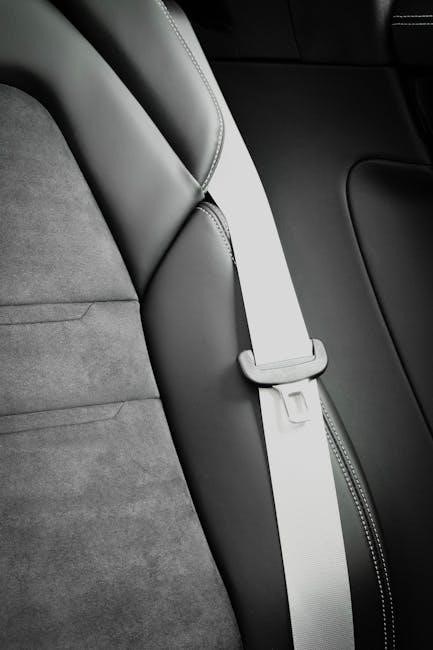The Safety 1st All-in-One Car Seat Manual provides essential guidance for safe installation, usage, and maintenance of versatile car seats designed for infants, toddlers, and children up to 100 pounds.
It covers models like the Turn and Go 360 DLX and EverFit, offering features such as rotational technology, side impact protection, and booster compatibility, ensuring comfort and safety throughout your child’s growth.
Overview of Safety 1st All-in-One Car Seat
The Safety 1st All-in-One Car Seat is a versatile and reliable solution for parents seeking a car seat that adapts to their child’s growth. Designed to accommodate infants, toddlers, and older children, it transitions seamlessly through three modes: rear-facing, forward-facing, and booster. Models like the Turn and Go 360 DLX and EverFit offer innovative features such as 360-degree rotation for easy access, side impact protection, and energy-absorbing foam for enhanced safety.
These seats are built to last, supporting children from 5 to 100 pounds, ensuring long-term use. The Turn and Go 360 DLX features SecureTech, a visual indicator confirming proper belt tension, while the EverFit model provides a straightforward installation process. With a focus on comfort and safety, Safety 1st car seats are a top choice for parents prioritizing convenience and protection for their children.
Benefits of Using an All-in-One Car Seat
Using a Safety 1st All-in-One Car Seat offers numerous benefits for parents and children alike. Its versatility allows it to grow with your child, eliminating the need for multiple seats as they outgrow each stage. This not only saves money but also reduces the hassle of frequent purchases and installations. The 360-degree rotation feature, found in models like the Turn and Go 360 DLX, makes buckling and unbuckling easier, reducing strain on parents’ backs. Additionally, the seat’s adjustable harness and booster capabilities ensure a secure fit for children from 5 to 100 pounds. Enhanced safety features, such as side impact protection and energy-absorbing foam, provide peace of mind for parents. The All-in-One car seat also promotes proper posture and comfort, ensuring a pleasant ride for children. With its durable design and easy maintenance, it’s a practical and safe investment for families.
Key Features of Safety 1st Car Seats
Safety 1st car seats are engineered with advanced safety and convenience features. The Turn and Go 360 DLX model boasts a 360-degree rotational design, allowing easy access for parents to buckle and unbuckle their child without strain. SecureTech indicators provide visual confirmation of proper belt tension, ensuring a secure installation. Many models feature side impact protection and energy-absorbing foam to enhance safety in the event of a crash. The adjustable harness and headrest accommodate growing children, while the booster mode supports older kids up to 100 pounds. Additional features include washable fabrics, cup holders, and storage compartments for added convenience. The EverFit model offers a sleek design with a steel-reinforced frame for durability. These features combine to provide a safe, comfortable, and practical solution for families, ensuring long-term use and adaptability as children grow.

Installation Guidelines
Read the manual thoroughly, ensure vehicle compatibility, and follow step-by-step instructions for secure installation using seatbelt or LATCH system. Proper leveling, tightening, and top tether use are critical for optimal safety and protection.
Preparation for Installation
Before installing your Safety 1st All-in-One Car Seat, read the manual thoroughly to understand the instructions and safety guidelines. Ensure the car seat is compatible with your vehicle by checking the manufacturer’s specifications. Verify the car seat’s manufacture date matches or exceeds the manual’s effective date. Wash any removable fabric covers and harness pads according to the instructions to ensure cleanliness. Familiarize yourself with the car seat’s components, such as the base, harness, and tether. For models like the Turn and Go 360 DLX, understand the rotational feature and SecureTech indicators for proper installation. Locate your vehicle’s seatbelt or LATCH system and ensure the seating area is clear of obstructions. Proper preparation ensures a safe and secure installation, maximizing your child’s protection. Always follow the manual’s guidance to avoid common installation mistakes and ensure compliance with safety standards. Preparation is the first step toward a safe and stress-free car seat setup.
Step-by-Step Installation Process
Begin by positioning the Safety 1st All-in-One Car Seat base in your vehicle, ensuring it fits snugly on the seat. For rear-facing installations, locate the vehicle’s LATCH anchors or use the seatbelt to secure the base. Tighten the base using the leveling foot and recline adjustment to achieve the correct angle. For models like the Turn and Go 360 DLX, utilize the SecureTech indicators to confirm proper tension. Once the base is secure, attach the top tether to the vehicle’s designated anchor point to enhance stability. For forward-facing installations, follow similar steps, ensuring the seat is upright and tightly fastened. After installation, perform a final check by shaking the seat gently to confirm it is firmly in place. Always refer to the manual for specific instructions tailored to your car seat model, such as the EverFit or Grow and Go, to ensure a safe and correct setup for your child. Proper installation is critical for maximizing safety.
Securing the car seat base is a critical step to ensure your child’s safety. For most Safety 1st models, including the EverFit and Grow and Go, you can use either the LATCH system or a vehicle seatbelt. If using LATCH, attach the connectors to the vehicle’s anchors, ensuring they click securely. Tighten the straps by pulling the webbing until the base is snug against the vehicle seat. For seatbelt installation, thread the belt through the designated path on the base and fasten it, then tighten by pulling the belt firmly. The Turn and Go 360 DLX features SecureTech indicators, which change from red to green when proper tension is achieved. After securing, check the base by tugging it gently to ensure no movement. Always refer to your specific model’s manual for detailed instructions, as some models may have unique features or requirements. Properly securing the base is essential to ensure the car seat functions correctly in the event of a crash. The top tether is a crucial component for enhancing the safety of your Safety 1st All-in-One Car Seat, particularly when used in forward-facing mode. To use it effectively, locate the top tether anchor point in your vehicle, typically found on the rear shelf or backseat. Attach the tether strap from the car seat to this anchor, ensuring it is securely connected. Tighten the strap until it feels snug, with no slack, to minimize movement of the car seat. For models like the Turn and Go 360 DLX, the SecureTech indicators can provide visual confirmation when the tether is properly tightened. Always refer to your specific car seat manual for model-specific instructions, as the process may vary slightly. Correct use of the top tether significantly reduces the risk of injury by stabilizing the car seat during sudden stops or crashes, ensuring your child’s safety and giving you peace of mind while driving. Regularly inspect the tether for any signs of wear or damage to maintain its effectiveness. By following these steps, you can ensure your child’s car seat is optimally secured for maximum protection. The Safety 1st All-in-One Car Seat accommodates your child’s growth with adjustable features, ensuring proper fit and comfort. Regularly check and adjust the harness, headrest, and seat position to match your child’s height and weight. The Safety 1st All-in-One Car Seat is designed to accommodate children across various growth stages, ensuring safety and comfort. For rear-facing use, the seat is suitable for infants weighing 5 to 40 pounds, while forward-facing mode supports toddlers from 22 to 65 pounds. The booster mode is designed for children weighing between 40 and 100 pounds, providing extended usability as your child grows. Height limits typically range from 19 to 57 inches, depending on the model and configuration. Always refer to your specific car seat manual for precise height and weight guidelines, as these may vary slightly between models like the EverFit and Turn and Go 360 DLX. Proper adherence to these limits ensures optimal protection and a secure fit, aligning with safety regulations and your child’s developmental needs. Regularly checking and adjusting the seat’s configuration as your child grows is crucial for maintaining safety and comfort over time. Properly adjusting the harness of your Safety 1st All-in-One Car Seat is crucial for ensuring your child’s safety and comfort. The harness should fit snugly against your child’s body, with the shoulder straps positioned at or slightly below their shoulders when rear-facing, and at or slightly above when forward-facing. The chest clip should be placed at armpit level, ensuring it lies flat against the chest. For infants, the crotch strap should be adjusted to prevent excessive movement, while for older children, it should provide adequate support without causing discomfort. Always test the harness by pinching the shoulder straps at your child’s shoulder; if you can pinch any excess material, it needs to be tightened. Regularly check and adjust the harness as your child grows, ensuring it remains snug and properly aligned. Refer to your manual for specific instructions, as slight variations may exist between models like the EverFit and Turn and Go 360 DLX. Proper buckling techniques are essential for ensuring your child’s safety while using the Safety 1st All-in-One Car Seat. Always start by securing the chest clip at armpit level, ensuring it lies flat against your child’s chest. Next, tighten the harness straps by pulling the adjustment strap until they fit snugly against your child’s body, with no slack. For rear-facing installations, the shoulder straps should be positioned at or slightly below your child’s shoulders, while forward-facing installations require them to be at or slightly above. After securing your child, double-check that the buckles are fully engaged and cannot be easily opened. Avoid dressing your child in bulky clothing, as this can interfere with the harness fit. Regularly inspect the straps for twists or tangles and ensure the harness is properly aligned. Always refer to your Safety 1st manual for model-specific instructions, as features may vary between models like the EverFit and Turn and Go 360 DLX. Consistent and correct buckling ensures optimal protection in the event of sudden stops or collisions. Regularly clean the Safety 1st All-in-One Car Seat using mild soap and water, avoiding harsh chemicals that could damage materials. Inspect for wear, frays, or damage, and replace immediately if any issues are found. Store the car seat in a cool, dry place when not in use, away from direct sunlight. Follow the manual’s specific care instructions for optimal longevity and safety performance over time. Cleaning the Safety 1st All-in-One Car Seat is essential for maintaining hygiene and ensuring your child’s comfort. Start by removing any loose debris or toys from the seat. For washable parts, such as the seat pad and harness covers, check the manual for specific instructions. Most models allow machine washing with mild detergent on a gentle cycle, but always avoid harsh chemicals or bleach, as they may damage the materials. For non-removable sections, use a soft cloth dampened with water and a small amount of mild soap to wipe away stains or spills. Avoid soaking the seat or using abrasive cleaners, as this could compromise its structural integrity. Allow all cleaned parts to air dry thoroughly before reassembling the car seat; Regular cleaning helps prevent odors and keeps the seat looking its best. Always refer to the manual for specific guidance, as improper cleaning methods could void the warranty or affect safety performance. Regularly inspecting your Safety 1st All-in-One Car Seat for damage is crucial to ensure your child’s safety. Start by examining the harness, buckles, and seat base for any signs of wear, fraying, or cracks. Check the padding and fabric for stains, tears, or deterioration. Inspect the expiration date on the seat, as car seats have a limited lifespan and must be replaced after a certain period. Look for any damage to the plastic shell, headrest, or armrests. If you notice any structural issues, discontinue use immediately. For minor damage, consult the manual or contact Safety 1st customer support. Never use a car seat that has been in an accident or shows significant wear. Proper inspection ensures the seat remains safe and functional, protecting your child in the event of a crash. Proper storage and transportation of your Safety 1st All-in-One Car Seat are essential to maintain its safety and functionality. Always clean the seat thoroughly before storing it to prevent mold or mildew. Store the car seat in a dry, cool place away from direct sunlight, avoiding basements or attics prone to moisture. If storing for an extended period, keep the seat in its original packaging or a sturdy box to protect it from dust and damage. When transporting the car seat, ensure it is securely fastened in the vehicle to prevent movement. Never leave the car seat unattended in a hot car, as extreme temperatures can degrade materials. For air travel, check airline regulations and use a protective cover to shield the seat during transit. Always follow the manual’s guidance for handling and moving the seat to preserve its integrity and ensure your child’s continued safety. Address issues like loose installation or harness misalignment by consulting the manual. Ensure the base is tightly secured, and harness straps are properly adjusted for a snug, safe fit. Installation issues can often be resolved by ensuring the car seat base is securely fastened. Check that the seatbelt or LATCH system is tightly fitted, and the base is level. For models like the Turn and Go 360 DLX, use the SecureTech indicators to confirm proper tension. If the base feels loose, refer to the manual for guidance on tightening the straps or adjusting the position. Additionally, verify that the top tether is correctly attached to the vehicle’s anchor point, as this provides added stability. For persistent problems, consult the troubleshooting section of the manual or contact Safety 1st customer support. Always ensure the car seat’s manufacture date meets the manual’s effective date for compliance. Regularly inspect the installation to maintain your child’s safety and make adjustments as needed. Proper installation is critical to ensuring the car seat functions as intended in the event of a crash. Ensuring a proper harness fit is crucial for your child’s safety. Start by adjusting the harness height to match your child’s shoulders, ensuring it is snug but not overly tight. Use the pinch test: if you can pinch any excess webbing, the harness is too loose. For models like the Turn and Go 360 DLX, the harness can be adjusted using the front harness adjuster or the back adjustment strap, depending on the seat’s design. Always refer to the manual for specific instructions. The chest clip should be positioned at your child’s armpit level, ensuring even distribution of forces. If the harness seems too tight, loosen the straps slightly but maintain a snug fit. Regularly check the harness fit as your child grows, especially after size changes or extended use. For booster configurations, ensure the vehicle’s seatbelt is correctly routed through the guide to maintain proper fit. Adjustments should be made with your child seated upright and the car seat installed correctly in the vehicle. Proper harness fit ensures optimal protection in the event of sudden stops or collisions. Car seats, including Safety 1st models, have expiration dates to ensure safety and reliability over time. Most expire 6-10 years from the manufacture date, located on the seat’s label. Check the manual for specific details, as expiration varies by model. Factors like material degradation, advancements in safety standards, and wear and tear necessitate replacement. After an accident, even minor, the seat must be replaced. Always adhere to the manufacturer’s guidelines for expiration and replacement. Proper disposal is crucial; check local regulations for guidance. Never use a seat past its expiration date, as it may not provide adequate protection. Planning ahead for replacement ensures your child’s continued safety as they grow. For more details, consult the Safety 1st manual or visit their official website for resources and support. Understanding expiration ensures your child’s car seat remains a reliable safety device. Always prioritize your child’s safety by following the Safety 1st All-in-One Car Seat Manual. Regular checks, proper installation, and adherence to guidelines ensure a secure and comfortable ride for your little one. Before each use, perform a final safety check to ensure your child’s car seat is secure and properly fitted. Verify that the harness is snug, with no excess material, and the chest clip is at armpit level. Check that the seatbelt or LATCH system is tightly secured, with no looseness at the base. For models like the Turn and Go 360 DLX, ensure the seat is firmly locked in place after rotation; Inspect the top tether for proper tightening and connection to the vehicle anchor. Ensure the car seat is level and evenly positioned in the vehicle. Always refer to the manual for specific adjustments and guidelines. Conducting this final check helps prevent accidents and ensures your child’s maximum protection while traveling. This routine ensures your child’s safety and your peace of mind on every journey. Adhering to the Safety 1st All-in-One Car Seat Manual is crucial for ensuring your child’s safety and the proper functioning of the car seat. The manual provides detailed instructions tailored to specific models, such as the Turn and Go 360 DLX and EverFit, guiding users through installation, usage, and maintenance. Proper installation is vital to prevent accidents, as incorrect use can lead to ineffective protection. The manual outlines weight limits, harness adjustments, and proper securing methods, all essential for optimal safety. Failure to follow these guidelines may result in loose seatbelts, misaligned harnesses, or improper use of features like the top tether, which can jeopardize your child’s protection. Additionally, many jurisdictions legally require car seats to be used according to the manufacturer’s instructions, and non-compliance may lead to penalties. By following the manual, parents can ensure their car seat is used correctly, providing peace of mind and confidence in their child’s safety during travel. For comprehensive car seat safety, Safety 1st provides detailed user manuals and guides on their official website, ensuring access to specific instructions for models like the Turn and Go 360 DLX and EverFit. These resources include step-by-step installation tips, weight limits, and maintenance advice. Additionally, parents can find instructional videos and FAQs addressing common concerns. Community forums and parenting websites often share real-user experiences and troubleshooting tips, offering practical insights. The National Highway Traffic Safety Administration (NHTSA) also provides a wealth of information on car seat safety standards and best practices. Local resources, such as fire stations or children’s hospitals, frequently offer free car seat safety checks conducted by certified technicians. These resources collectively empower parents to ensure their child’s car seat is used safely and correctly, aligning with the guidelines outlined in the Safety 1st All-in-One Car Seat Manual.Securing the Car Seat Base
Using the Top Tether for Added Safety

Usage and Adjustment
Height and Weight Limits
Adjusting the Harness
Proper Buckling Techniques

Maintenance and Care

Cleaning the Car Seat
Inspecting the Car Seat for Damage

Storage and Transportation Tips

Troubleshooting Common Issues

Resolving Installation Problems

Addressing Harness Fit Issues
Understanding Expiration and Replacement

Final Safety Check
Importance of Following the Manual
Additional Resources for Car Seat Safety
